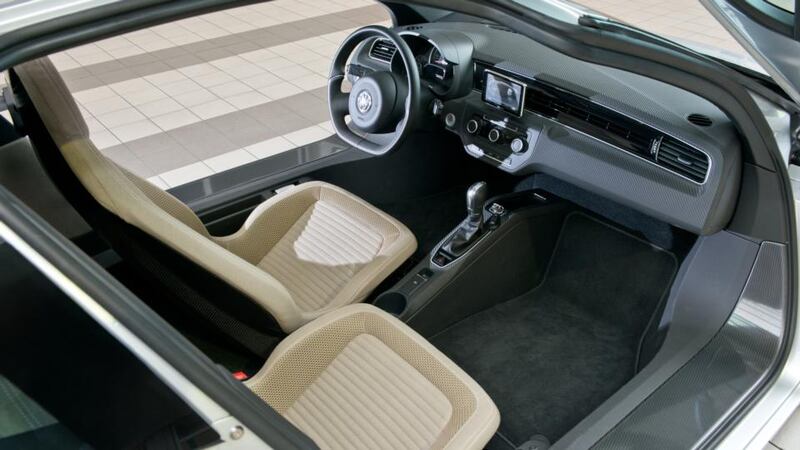What does the world's most fuel-efficient production car have in common with the world's fastest and most powerful? Much more than you might think. The Volkswagen XL1 and the Bugatti Veyron are both the brainchildren of VW's Bond villain-like Chairman, Dr Ferdinand Piech.
In both cases, he simply set his engineers some almost impossible targets, and told them to get on with it. In the case of the Veyron, he wanted a 1,000-horsepower car costing €1m and capable of 400km/h. In the case of the XL1, he demanded a production car that could drive 100km on less than a litre of fuel.
In both cases – and doubtless at the expense of a lot of sleepless nights and broken marriages – the engineers managed it. Both cars come at a serious financial cost, too, both to Volkswagen and to buyers of the cars. One recent report estimates that despite that sky-high price, VW loses €4.6m on every Veyron it sells. And although the XL1 will be sold for an equally eye-watering €110,000, the hugely expensive lightweight construction that makes that amazing fuel-efficiency figure possible means that VW will also make a loss on every XL1 it sells. So just 200 will be hand-made at VW’s Osnabrück plant in Germany.


But don’t think that the XL1 is just an expensive eco-irrelevance. There is method to Dr Piech’s madness. What his engineers learned developing both the Veyron and the XL1 should one day influence cars we might have a hope of affording. In the case of the XL1, the plug-in two-cylinder 800cc diesel-electric powertrain, which can travel around 50km on electric power alone and more than 500km on its tiny 10-litre fuel tank, is interesting (the fuel economy figure incudes electric-only running). But it’s the body it’s fitted to that makes the headlines – and brings the cost.
Real hypercar features
Just like the Veyron, the XL1 is largely made of carbon fibre, with some real hypercar features, like the magnesium wheels and ceramic brake discs. It's also the world's most aerodynamic production car, with cameras instead of bulky wing mirrors. But in other respects, you get less than in a VW Polo, with ultra-narrow, low rolling-resistance tyres, no power steering, manual window winders (remember them?) and a single wiper blade, all aimed at cutting weight and increasing efficiency.
But does the XL1 feel more supercar or supermini to drive? It certainly has supercar kerb appeal; its footprint is about the same as a Polo’s but it’s lower than a Veyron, with sensational, slippery styling and dramatic gullwing doors. These admit you to a surprisingly spacious cabin, the passenger seat (there are only two) set slightly behind the driver’s to maximise shoulder space as the car tapers to the rear.
The XL1 usually moves off on electric power at first, the lack of engine noise drawing your attention to the scraping of the ceramic brakes and the road noise carried into the cabin on rough surfaces; there’s minimal sound-deadening, again to save weight. When the engine, mounted just behind your right ear, does cut in, it does so with a lawnmower clatter. Even with both electric and diesel engines running, the XL1 can summon only 68bhp and takes a leisurely 12.7 seconds to reach 100km/h, though that dolphin-like shape means it has to be electronically limited to 160km/h and would run on to around 200km/h if derestricted.
Hoot to drive
But the XL1 is still a hoot to drive. Firstly, just getting to drive something this special, rare and with this level of technology is a thrill, and explains why VW expects the run of 200 to be oversubscribed, even at that price. Second, despite the low driving position, the thin pillars make placing the XL1 easy, and the unassisted steering and narrow yet grippy tyres make for an involving drive. It feels quicker than those figures suggest, the instant torque of the electric motor giving the 795kg XL1 enough mid-range acceleration to exploit gaps in traffic and even feel fun.
But there's more fun to be had in keeping one eye on the various system and efficiency monitors and trying to extract your personal best-ever fuel consumption figure from the XL1: something you occasionally have to do in the Veyron too, if only to nurse the thirsty beast to the nearest fuel station.
ENGINE
Plug-in hybrid: 2cyl, 800cc, 48PS; Diesel: 27PS electric motor
SPECIFICATIONS
Mid-engined, rear-wheel drive; Carbon-fibre body and panels; 2 seats; 795kg
PERFORMANCE
0-100km/h: 12.7sec, 160km/h max (ltd); 0.9l/100km, 313mpg
EMISSIONS
21g/km CO2; 10-litre fuel tank
PRICE
€110,000 (est)
















